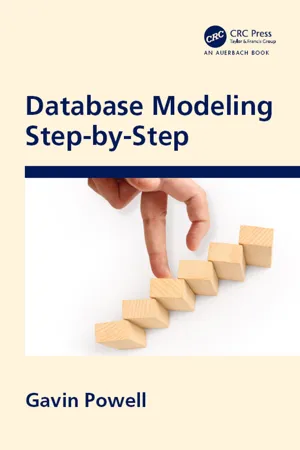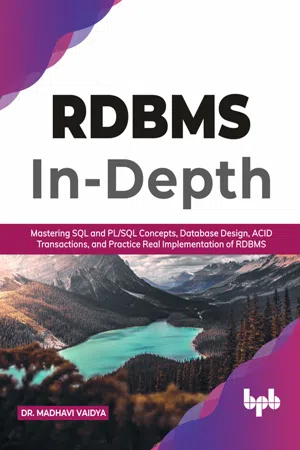Computer Science
SQL SET
SQL SET is a command used in Structured Query Language (SQL) to modify data in a database table. It allows users to update, insert, or delete data in a table. The SET command is often used in conjunction with the UPDATE statement to modify specific data in a table.
Written by Perlego with AI-assistance
Related key terms
3 Key excerpts on "SQL SET"
- eBook - ePub
- Gavin Powell(Author)
- 2020(Publication Date)
- Auerbach Publications(Publisher)
This chapter shows how the relational database model is used from an application perspective. There is little point in understanding something such as relational database modeling without seeing it applied in some way, and so this chapter looks at how a database model is accessed by applications. A relational database model contains tables, where rows in tables are accessed using a computer programming language called Structured Query Language (SQL). SQL is a declarative programming language that is used to read data from tables and update data in those tables.A declarative programming language describes what you are coding without describing how the problem is solved, which can be difficult to understand, because declarative code requires all instructions in a single complex instruction. Other computer programming languages such as C and FORTRAN are procedural or modular and break software down into separate parts called modules; and then there is Java, which is object-oriented.When a database model is well designed, the creation of SQL code can be a simpler process, which also can imply that difficulties encountered in coding of SQL queries can often indicate database model design flaws, or just too much granularity in a data model.This chapter covers:• What SQL is • The origins of SQL • Different types of queries • Changing data in tables • Changing table structureSQL is a declarative computer programming language used for accessing row and column values in relational database tables:4.1 What is SQL?
• SQL is structured in the sense that it is used to access structured data from tables in a relational database. • Use of the word “language” implies a computer programming language that has specific syntax for performing specific tasks.• SQL is a declarative language consisting of single commands where the database itself does a lot of the work in deciding how to get that information. In other words, SQL tells the database what it wants, and the database does some of the logical assessment, because logic is built into a relational database using keys and relationships between tables. A procedural language, on the other hand, contains blocks of commands, where those blocks of commands are sequences of distinct steps, typically where each successive step is dependent on the result of the previous step (command) in the sequence. - eBook - ePub
Learning PostgreSQL 11
A beginner's guide to building high-performance PostgreSQL database solutions, 3rd Edition
- Salahaldin Juba, Andrey Volkov(Authors)
- 2019(Publication Date)
- Packt Publishing(Publisher)
SQL Language
Structured Query Language (SQL ) is used to set up the structure of the database, to manipulate the data in a database, and to query the database. This chapter is dedicated to the Data Manipulation Language (DML ) that is used to create data in a database, change or delete it, and retrieve it from the database.After reading this chapter, you will understand the concept of SQL and the logic of SQL statements. You will be able to write your own SQL queries and manipulate data using this language. A complete reference for SQL can be found in the official PostgreSQL documentation at http://www.postgresql.org/docs/current/static/sql.html .The topics that we will cover in this chapter are as follows:- SQL fundamentals
- Lexical structure
- Querying data with SELECT statements
- Changing data in a database
The code examples in this chapter are based on the prototype of a car portal database described in the previous chapters. The scripts to create the database and fill it with sample data can be found in the attached media. They are called schema.sql and data.sql. All of the code examples from this chapter can be found in the examples.sql file.Refer to Chapter 2 , PostgreSQL in Action , for details on how to use the psql utility.Passage contains an image
SQL fundamentals
SQL is used to manipulate the data in a database and to query the database. It's also used to define and change the structure of the data—in other words, to implement the data model. You already know this from the previous chapters.In general, SQL has three parts:- Data Definition Language (DDL )
- DML
- Data Control Language (DCL )
The first part is used to create and manage the structure of the data, the second part is used to manage the data itself, and the third part controls access to the data. Usually, the data structure is defined only once, and then it's rarely changed. However, data is constantly inserted into the database, changed, or retrieved. For this reason, the DML is used more often than the DDL. - eBook - ePub
RDBMS In-Depth
Mastering SQL and PL/SQL Concepts, Database Design, ACID Transactions, and Practice Real Implementation of RDBM (English Edition)
- Dr. Madhavi Vaidya(Author)
- 2021(Publication Date)
- BPB Publications(Publisher)
HAPTER 3Relational Query Languages
Introduction
This chapter introduces the readers to the Structured Query Language or SEQUEL. Structured Query Language is a set of commands, which is used for interacting with relational databases. SQL is used for a vast range of purposes, including data warehousing, e-commerce, and many more applications as backend.SQL is a query language that is used to retrieve and send information, and organize information in a database. SQL is widely used in business, and in other types of database administration. It allows to write various types of queries like pattern matching or using the logical or relational operators. Finally, towards the end of the chapter we will learn the data dictionaries in SQL, and how to create the constraints and to name them.Structure
- Introduction to SQL
- SQL datatypes
- Components of SQL
- Relational and Logical operators
- Range operators (In, Between, Like, NULL Predicate)
- Clauses (Distinct, where)
- Constraints
- Implementation of constraints in SQL
- Integrity constraints
- Referential integrity constraints
- Business constraints
- Understanding data dictionary
Objectives
After studying this unit, you should be able to:- Understand SEQUEL or SQL, and its importance
- Know the various datatypes used in SQL
- Find and execute various operators
- Understand the rage operators and various clauses
- Know the use of various types of constraints and their role in SQL
- Understand the concept of data dictionary
In the last chapter, we were introduced to the various operators and their use in RDBMS. In addition to it, we learnt an important concept of ER model and the need of such design approach for database designing.Finally, we understood what is normalization. We will learn the various forms of normalization in later chapters. This chapter is focused on learning the SEQUEL or SQL, which is very important to understand backend and the usage of SQL queries.
Index pages curate the most relevant extracts from our library of academic textbooks. They’ve been created using an in-house natural language model (NLM), each adding context and meaning to key research topics.


